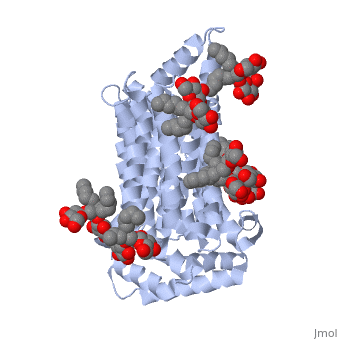Sandbox Reserved 1358
From Proteopedia
| (3 intermediate revisions not shown.) | |||
| Line 8: | Line 8: | ||
== Structure == | == Structure == | ||
| - | GLUT3 transport protein is composed of 481 amino acids, two alpha helical protein chains, and two different ligands, ligand Y01 and ligand 37X. On the protein, one ligand Y01, known as Cholesterol hemisuccinate, is attached to chain a, and one to chain b. Ligand 37X is called Octyl Glucose Neopentyl Glycol, and there are 6 of these ligands on chain a and 3 on chain b. | + | GLUT3 transport protein is composed of 481 amino acids, <scene name='77/777678/Two_protein_chains/1'>two alpha helical protein chains</scene>, and two different ligands, ligand <scene name='77/777678/Ligand_y01/1'>Y01</scene> and ligand <scene name='77/777678/Ligand_37x/1'>37X</scene>. On the protein, one ligand Y01, known as Cholesterol hemisuccinate, is attached to chain a, and one to chain b. Ligand 37X is called Octyl Glucose Neopentyl Glycol, and there are 6 of these ligands on chain a and 3 on chain b. |
== Disease == | == Disease == | ||
| + | Correlations between low levels of glucose transport proteins and abnormal hyperphosphorylation of tau in Alzheimer Disease. Individuals with Alzheimer Disease have decreased levels of GLUT3 and GLUT1 in their brain. | ||
| - | == | + | </StructureSection> |
| + | == References == | ||
| + | Kayano, T., Fukumoto, H., Eddy, R. L., Fan, Y. S., Byers, M. G., Shows, T. B., & Bell, G. I. (n.d.). Cell Glucose Transport and Glucose Handling During Fetal and Neonatal Development. Retrieved from Journal of Biological Chemistry website: http://www.jbc.org/content/263/30/15245.short | ||
| - | + | Liu, Y., Liu, F., Iqbal, K., Grundke-Iqbal, I., & Gong, C.-X. (2008). Decreased glucose transporters correlate to abnormal hyperphosphorylation of tau in Alzheimer disease. FEBS Letters, 582(2), 359–364. http://doi.org/10.1016/j.febslet.2007.12.035 | |
| - | + | Simmons, R. A. (2017). Cell Glucose Transport and Glucose Handling During Fetal and Neonatal Development. Retrieved from Science Direct website: https://www.sciencedirect.com/topics/biochemistry-genetics-and-molecular-biology/glut3 | |
| - | + | Simpson, I. A., Dwyer, D., Malide, D., Moley, K. H., Travis, A., & Vannucci, S. J. (2008). The facilitative glucose transporter GLUT3: 20 years of distinction. American Journal of Physiology - Endocrinology and Metabolism, 295(2), E242–E253. http://doi.org/10.1152/ajpendo.90388.2008 | |
| - | + | ||
| - | + | ||
Current revision
| This Sandbox is Reserved from January through July 31, 2018 for use in the course HLSC322: Principles of Genetics and Genomics taught by Genevieve Houston-Ludlam at the University of Maryland, College Park, USA. This reservation includes Sandbox Reserved 1311 through Sandbox Reserved 1430. |
To get started:
More help: Help:Editing |
GLUT3 / SLC2A3
| |||||||||||
References
Kayano, T., Fukumoto, H., Eddy, R. L., Fan, Y. S., Byers, M. G., Shows, T. B., & Bell, G. I. (n.d.). Cell Glucose Transport and Glucose Handling During Fetal and Neonatal Development. Retrieved from Journal of Biological Chemistry website: http://www.jbc.org/content/263/30/15245.short
Liu, Y., Liu, F., Iqbal, K., Grundke-Iqbal, I., & Gong, C.-X. (2008). Decreased glucose transporters correlate to abnormal hyperphosphorylation of tau in Alzheimer disease. FEBS Letters, 582(2), 359–364. http://doi.org/10.1016/j.febslet.2007.12.035
Simmons, R. A. (2017). Cell Glucose Transport and Glucose Handling During Fetal and Neonatal Development. Retrieved from Science Direct website: https://www.sciencedirect.com/topics/biochemistry-genetics-and-molecular-biology/glut3
Simpson, I. A., Dwyer, D., Malide, D., Moley, K. H., Travis, A., & Vannucci, S. J. (2008). The facilitative glucose transporter GLUT3: 20 years of distinction. American Journal of Physiology - Endocrinology and Metabolism, 295(2), E242–E253. http://doi.org/10.1152/ajpendo.90388.2008

